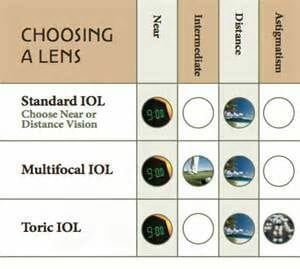By Dr. Mark S. Siegel
Approximately 25 million Americans have cataracts, the condition that causes cloudy, blurry or dim vision. Many will have cataract surgery each year to restore their vision.
During cataract surgery, the natural clouded lens is replaced with an artificial lens called an intraocular lens or IOL. What patients new to cataract surgery may not know is that they have a variety of IOL types to choose from, all with different benefits.
Types of IOLs include monofocal, multifocal, and toric lenses. To help people understand the differences between the lens types, here is a list of questions to consider when deciding on IOLs. The patient’s ophthalmologist will recommend which lens they believe is most appropriate for the patient based on his or her daily activities and other needs, but these questions may provide a good starting point.
Is cost or coverage a factor in your decision?
Not all IOL types are covered by insurance. But, Medicare and most insurance companies do cover the cost of the most traditional option, monofocal lenses. These lenses have been used for decades and are the most popular. Monofocals are set to provide the best possible, corrected vision at near, intermediate or far distances. Most people who choose monofocals have their IOLs set for distance vision and use reading glasses for near activities.
Do you often use smart phones, tablets or computers? Do you prefer to see both near and far and reduce the need for glasses?
Newer IOLs called multifocal lenses may enable wearers to see both near and distant objects. Meanwhile, they can also reduce or eliminate the need for glasses or contact lenses. But, these lenses are more expensive and not covered by insurance. In addition, the ability to read and perform other tasks without glasses varies from person to person.
Do you frequently drive at night?
If night driving is important, multifocal lenses may not be the best option. Side effects such as glare or halos around lights, or decreased sharpness of vision (also known as contrast sensitivity) may occur with these lenses, especially at night or in dim light. Most people adapt to these effects, but those who frequently drive at night may be more satisfied with monofocal IOLs.
Do you have moderate to advanced astigmatism?
With astigmatism, the cornea – the clear front window of the eye – is not round and smooth like a basketball, but instead is curved like a football. This distorts or blurs the ability to see both near and distant objects. People with significant degrees of astigmatism are usually most satisfied with toric IOLs. Toric lenses have extra built-in correction for astigmatism. People who want to reduce (or possibly eliminate) the need for eyeglasses may opt for an additional treatment called limbal relaxing incisions, which are typically performed at the time of cataract surgery. These are peripheral corneal incisions that are most commonly performed with a femtosecond laser during laser cataract surgery. Insurance does not cover laser cataract surgery with toric lenses or limbal relaxing incisions.
Whether a patient chooses laser cataract surgery or manual surgery, multifocal or toric IOLs, it is important to establish reasonable expectations with your ophthalmologist. That way both the patient and surgeon will have the best chance of meeting expectations and having the best possible outcome: a happy patient whose visual goals are achieved.
Dr. Mark Siegel, MD, FAAO is the Medical Director at Sea Island Ophthalmology in Beaufort. He may be reached at 843-525-1500. Learn more at www.seaislandophthalmology.com.






